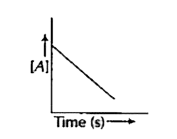Complete the following reaction.
C6H5N+2Cl−H2O−−−−−−−−−−→Room temperatureSolution in Odia
Step by step video & image solution for Complete the following reaction. C_(6)H_(5)N_(2)^(+)Cl^(-) overset(H_(2)O)underset("Room temperature") to by Chemistry experts to help you in doubts & scoring excellent marks in Class 12 exams.
Updated on:21/07/2023Topper's Solved these Questions
- SAMPLE PAPER 4 BOOK - ARIHANT PUBLICATIONCHAPTER - SAMPLE PAPER 4 EXERCISE - GROUP C
7 Videos
- SAMPLE PAPER 4 BOOK - ARIHANT PUBLICATIONCHAPTER - SAMPLE PAPER 4 EXERCISE - GROUP A
7 Videos
- SAMPLE PAPER 1 BOOK - ARIHANT PUBLICATIONCHAPTER - SAMPLE PAPER 1 EXERCISE - GROUP C
14 Videos
- SAMPLE PAPER 5 BOOK - ARIHANT PUBLICATIONCHAPTER - SAMPLE PAPER 5 EXERCISE - GROUP C
7 Videos
Similar Questions
Consider the reaction, Ak−−→P. The change in the concentration of A with time is shown in the following plot:

(a) Derive the expression for the time required for the completion of the reaction.
(b) Predict the order of the reaction.
View SolutionHydrofluoric acid exists as a ......... molecule.
View SolutionA strip of nickel metal is dipped in a 1 molar solution of Ni(NO3)2 and a strip of silver metal is dipped in a 1 molar solution of AgNO3. An electrochemical cell is created when the two solutions are joined by salt bridge and two strips are joined by wire to a voltmeter.
Answer the following questions.
Write the balanced equation for the overall cell reaction and calculate the cell potential.
View SolutionThe chemistry of corrosion of iron is essentially an electrochemical phenomenon. Explain the reactions occurring during the corrosion of iron in the atmosphere. Suggest two materials other than hydrogen that can be used as fuels in fuel cells.
The molar conductivity of 0.025 mol L−1, methanoic acid is 46.1scm2mol−1. Calculate its degree of dissociation and dissociation constant.
View Solutionनिम्नलिखित अभिक्रियाओं को पूर्ण कीजिए-
(i) C6H5NH2+CHCI3+( ऐल्कोहॉली) KOH→
(ii) C6H5N2Cl+H3PO2+H2O→
(iii) C6H5NH2+H2SO4( सांद्र) →
(iv) C6H5N2Cl+C2H5OH→
(v) C6H5NH2+Br2(aq)→
(vi) C6H5N2Cl(i)HBF4−−−−−−−−−−−−−−→(ii)NaNO2/Cu.Δ
View SolutionC6H5N2ClCuCl−−→HClC6H5Cl अभिक्रिया है -
View SolutionC6H5N2ClCuCl−−→HClC6H5Cl अभिक्रिया है-
View SolutionC6H5N2ClCuCl−−→HClC6H5Cl+N2 अभिक्रिया का नाम लिखिए।
View Solutionनिम्नलिखित अभिक्रियाओं को पूर्ण कीजिए-
C6H5N2Cl+C2H5OH→
View SolutionC6H5N2ClCuCl−−→HClC6H5Cl अभिक्रिया है-
View SolutionWhat is Y in the following reaction sequence
C6H5N2ClH3PO2/H2O−−−−−−−→XCO.HCl−−−−−−−−→Anhy.AlCl3
View SolutionName the following reactions:
(i) C6H5N2+Cl−CuCl/HCl−−−−−−→C6H5Cl+N2
(ii) C6H5N2+Cl−Cu/HCl−−−−→C6H5Cl+N2+Cucl
View SolutionCompleter the following reactions.
(i) C6H5N+2Cl−H2O−−−−−→Δ(A)Zn−−−−−→Δ(B)
(ii) C6H5N+2Cl−CuCN−−−−−−→KCN(A)Na/C2H5OH−−−−−−−−→(B)
(iii)C6H5N+2Cl−Cu2Cl2/HCl−−−−−−−→(A)NaOH−−−−−−→Δ(B)
View SolutionWrite the structure of the major organic product in each of the following reactions : underset("(nitrobenzene)")(C_(6)H_(5)NO_(2))overset(Fe//HCl)rarr C_(6)H_(5)NH_(2)overset(NaNO_(2) //HCl)underset(0-5^(@)C)rarr C_(6)H_(5)N_(2)Cl overset(H_(2)O^(+))underset(Delta)rarr underset("(Phenol)")(C_(6)H_(5)OH)+N_(2)+HCl
View SolutionComplete the following reactions :
C6H5N2Cl+H3PO2+H2O→
View SolutionComplete the following reactions :
C6H5N2Cl+C2H5OH→
View Solution
